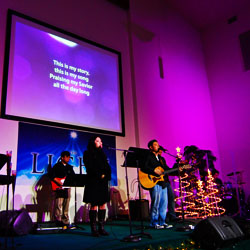As the holiday season system approaches, I’m sure many of you are planning for big Christmas services or productions.
Facing an extremely involved production at my church a few years ago, one night I woke up in a cold sweat realizing I had forgotten two mics and didn’t have the inputs for them.
As I plotted out my strategy to free up inputs where there seemed to be none, it occurred to me that many of you may be in the same boat. Christmas and Easter seem to always stretch our audio systems.
Whereas a 32-channel board might be fine all year, at Christmas you need 40-plus inputs. Or in our case, 56 is typically more than enough; in a few weeks I need 64-plus. In previous churches, I’ve run into this issue many times, on varying scales.
There are many ways to tackle the problem of too few inputs; I’ll talk about three of them, in ascending order of cost.
Trim The Input Count
This may seem obvious, but I’m amazed at how many people don’t really look at their inputs closely. Though you may have a “pulpit mic” channel, do you really need it for the big production? If not, you just freed up an input.
The same thing for other “permanently” patched mics like those for baptismals, overhead choir, CD and DVD players, even audience mics. If you don’t need them for the show, you can unplug them and reclaim the input.
Just remember to label those ends so you know where all those unplugged XLRs go back when you’re done.
Submix
When I was at Crosswinds in NY, I had a 32-channel board that was full most weekends. When Christmas hit, I was a good 16 channels short. I solved the problem there by swiping a board from the children’s ministry room (along with all their wireless mics…). I routed all of my wireless mics into the submixer, and sent that to the main board as a single mix.
Two things to keep in mind when submixing:
First, take extra care with gain structure. It’s easy to build a smokin’ hot mix in the submixer and overload the input channel on your main mixer. So be sure to watch that. On the other hand, don’t send too low a signal either, or noise will increase dramatically.
Second, use the submixer wisely. Don’t stick the random extra guitar, banjo, keys and four additional wireless drama mics over there. Find a big chunk of similar mics and put those together into a submix. Ideal candidates for this are all your drama mics or the drum kit.
Rent
Years ago, I was part of a church that ran a 32-channel SR-32 each week. For the big Christmas concert, we had 22 channels of wireless, a band and a small orchestra. Yeah, not going to fit.
And there was no room in the booth for a second mixer (and it would have had to be at least 32 channels). So I rented a ML-5000 from a local sound company. One of the reasons I went with that board was that mute automation that it offered.
We had so many scenes, back and forth between drama, music, more drama etc., that it would have been almost impossible to manage without some level of automation. We brought it in for a long weekend and it cost us a few hundred dollars, but it was money well spent.
A few words of warning: If you’re renting a board you’re not already familiar with, make sure you get it in enough time to learn it well. Also, rentals tend to book up for Christmas early, so if you haven’t booked a desk yet, you’d better hurry.
Finally, if you currently mix on a small analog desk, resist the urge to go rent a big digital desk like a (DiGiCo) SD8 or an (Avid) VENUE series, at least unless you’re really familiar with them already. Making that jump takes some time and you’ll be under enough pressure already. Find a big enough analog desk and your life will be much easier.
In my case for that extra-busy year, I did a combination of two of those. I trimmed some unnecessary inputs (one of my four video channels as I only needed three), and made sure I had exactly what was needed for the band. I brought in another stage rack. (Another option is an 8-input card.)
The rack gave me far more extra inputs than I needed and made it easier to wire up the band, but it can complicate monitoring.
But we figured it out—that’s what we do…
Mike Sessler now works with Visioneering, where he helps churches improve their AVL systems, and encourages and trains the technical artists that run them. He has been involved in live production for over 25 years and is the author of the blog Church Tech Arts.





















